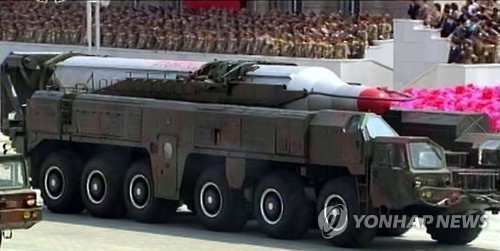North Korea on Tuesday attempted yet another launch of its Musudan intermediate-range ballistic missile that ended in failure, sending mixed signals to the international community less than two weeks after proposing talks with Seoul.
According to the Joint Chiefs of Staff, the missile was fired around 5:20 a.m. in Wonsan, Gangwon Province.
“The North has consistently been attempting ballistic missile launches since Kim gave the orders (for a ballistic missile test launch) on March 15. The military is on full alert in case of further provocations by the North,” said a JCS official. He added that additional analysis is necessary on details of the launch.
According to the Joint Chiefs of Staff, the missile was fired around 5:20 a.m. in Wonsan, Gangwon Province.
“The North has consistently been attempting ballistic missile launches since Kim gave the orders (for a ballistic missile test launch) on March 15. The military is on full alert in case of further provocations by the North,” said a JCS official. He added that additional analysis is necessary on details of the launch.

The Ministry of National Defense refused to formally comment on how far the missile flew but a military official said that the military was unable to determine the direction of the launch, indicating that the flight was too brief to determine even the rough course. There have been speculations within the military that it may have exploded from the launch pad.
Tuesday’s launch marked the fourth time the Musudan has been fired, with all attempts having ended in failure.
About 50 Musudan missiles, believed to be based on the Soviet R-27 submarine-launched ballistic missile, have been deployed by the North since 2007. The missile is presumed to have maximum range of 4,000 kilometers, which would have put the U.S. military range in Guam within its striking range.
But continued failures have raised questions about Pyongyang’s missile capacity.
On the coattails of Musudan’s first failed launch last month, some military officials had speculated the communist state would not fire it again until it had figured out the technical issues that hindered the first launch.
North Korea’s missile launch follows its proposal for working-level military talks on May 20, which the South Korean government rejected, questioning its sincerity and saying that the hermit kingdom should first renounce its nuclear program.
Kim Yong-hyun, a professor of North Korean studies at Dongguk University, said that the missile launch is part of its two-track method of offering talks and showing force to pressure the international community.
“The launch is (as much) aimed toward the U.S. and the international society as it is toward the South. The North appears to focus on improving its nuclear strike capacity by diversifying its means of launch,” he said.
Pyongyang in April held a test launch of its submarine-launched ballistic missile, which experts evaluated as a partial success in that it demonstrated the capacity for a submarine-based launch.
“Improving its nuclear strike capacity would have pressured the U.S. and the international society. I expect the North to continue its ‘carrot and stick’ approach,” said Kim.
In response to the North’s recent long-range rocket and nuclear tests, the U.N. Security Council in March passed a resolution that includes the strongest economic sanctions against it to date.
Pyongyang’s sole major trading partner China, which had been faithful to the resolution, had suggested resuming talks in parallel to the sanctions.
Ri Su-yong, vice chairman of the North Korean ruling party’s Central Committee and the country’s former foreign minister, made a surprise visit to China on Tuesday in what is seen as an attempt to mend ties between Beijing and Pyongyang.
By Yoon Min-sik (minsikyoon@heraldcorp.com)
Tuesday’s launch marked the fourth time the Musudan has been fired, with all attempts having ended in failure.
About 50 Musudan missiles, believed to be based on the Soviet R-27 submarine-launched ballistic missile, have been deployed by the North since 2007. The missile is presumed to have maximum range of 4,000 kilometers, which would have put the U.S. military range in Guam within its striking range.
But continued failures have raised questions about Pyongyang’s missile capacity.
On the coattails of Musudan’s first failed launch last month, some military officials had speculated the communist state would not fire it again until it had figured out the technical issues that hindered the first launch.
North Korea’s missile launch follows its proposal for working-level military talks on May 20, which the South Korean government rejected, questioning its sincerity and saying that the hermit kingdom should first renounce its nuclear program.
Kim Yong-hyun, a professor of North Korean studies at Dongguk University, said that the missile launch is part of its two-track method of offering talks and showing force to pressure the international community.
“The launch is (as much) aimed toward the U.S. and the international society as it is toward the South. The North appears to focus on improving its nuclear strike capacity by diversifying its means of launch,” he said.
Pyongyang in April held a test launch of its submarine-launched ballistic missile, which experts evaluated as a partial success in that it demonstrated the capacity for a submarine-based launch.
“Improving its nuclear strike capacity would have pressured the U.S. and the international society. I expect the North to continue its ‘carrot and stick’ approach,” said Kim.
In response to the North’s recent long-range rocket and nuclear tests, the U.N. Security Council in March passed a resolution that includes the strongest economic sanctions against it to date.
Pyongyang’s sole major trading partner China, which had been faithful to the resolution, had suggested resuming talks in parallel to the sanctions.
Ri Su-yong, vice chairman of the North Korean ruling party’s Central Committee and the country’s former foreign minister, made a surprise visit to China on Tuesday in what is seen as an attempt to mend ties between Beijing and Pyongyang.
By Yoon Min-sik (minsikyoon@heraldcorp.com)










![[Hello India] Hyundai Motor vows to boost 'clean mobility' in India](http://res.heraldm.com/phpwas/restmb_idxmake.php?idx=644&simg=/content/image/2024/04/25/20240425050672_0.jpg&u=)









